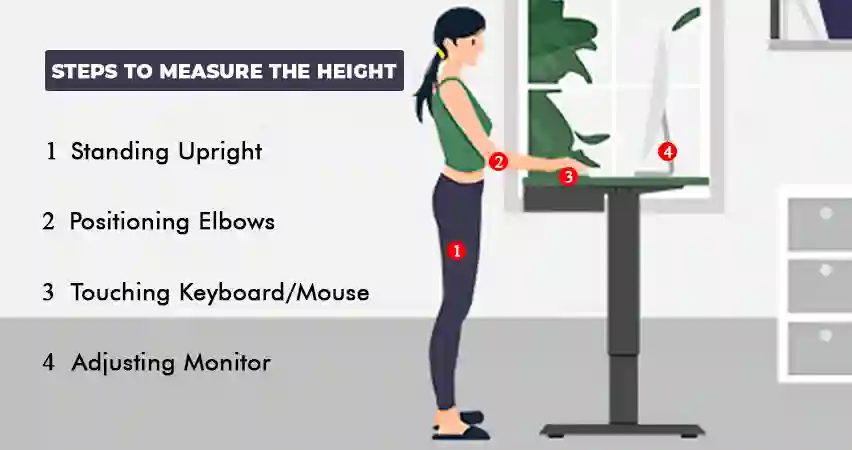How High Should A Standing Desk Be
How high should a standing desk be is totally dependent on the height of the user. A person with a 5.2 ft height cannot fit in a standing desk that’s been designed for a 6 ft tall person and vice-versa. Hence, it’s particularly important to find compatibility between your height and that of the standing desk you’re going to buy.
In order to create an ergonomically sound workspace, it should be ensured that your standing desk is designed to fit your body size and your work environment. If that’s not the case, you may end up hurting yourself in several ways such as poor blood circulation, visionary discomfort, and whatnot.
Even if you have a standing desk that’s totally compatible with your height, you need to use it effectively for reaping the maximum benefit. For instance, it should provide adjustable surfaces so that you can adjust the height and position of the keyboard and monitor for comfortable use.
This article will shed light on all of this, so keep reading!
How High Should A Standing Desk Be?
To help you determine the proper standing desk height for your body type and size, here is a simple yet effective technique i.e. standing desk height chart, which is given below:
Person’s Height ( Ft ) | Standing Desk Height ( Inches ) |
5’ - 5’ 2’’ | 31 - 33’’ |
5’ 3’’ - 5’ 5’’ | 34 - 36’’ |
5’ 6’’ - 5’ 8’’ | 37 - 39’’ |
5’ 9’’ - 5’ 11’’ | 40 - 42’’ |
6’ - 6’ 2’’ | 43 - 45’’ |
6’ 3’’ - 6’ 5’’ | 46 - 48’’ |
Measuring the Ideal Standing Desk Height
You may need to adjust the height of your sit-stand desk depending on your height and comfort. Adjustable standing desks are a great option for people of any height, as you can always customize the desk to fit your needs. But you should be completely aware that how a standing desk works.
Follow the given steps to ensure the perfect standing desk height according to your height:
Standing Upright
Firstly, stand still on the ground with your shoulders backward and arms down.
Positioning elbows
Then, make sure that your forearms are parallel to the ground and your elbows are at a 90-degree angle when you rest them on the desk
Touching Keyboard and Mouse
Next, adjust the desk so that your wrists rest comfortably on the surface in a straight and neutral position. Keeping wrists straight is the man and your fingers keep in touch with the keyboard and mouse that are placed on the desk in the desired locations.
Adjusting Monitor
Lastly, be sure that your monitor is placed arm’s length away. Adjust the height of the desk until your eyes are level with the top third of the monitor.
Drawbacks of Adjusting the Height of the Standing Desk Improperly
If you haven’t adjusted your standing desk at a proper height and using it for a long time, this can result in unfavorable conditions, some of which are discussed below:
Insufficient Blood Flow
The first and foremost drawback has to be insufficient blood flow. Standing for an extended period of time at an unadjusted desk significantly reduces blood flow to the worked-out muscles. Poor blood circulation results in sore feet, cramping muscles, and achy legs, particularly behind the knees. Your feet, ankles, and vertebral column may also experience numbness and momentary inactivity.
Vein Inflammation
Long periods of standing during work hours increase the risk of developing varicose veins. Your veins become inflamed because of the blood accumulating there. Blood clots may form that can travel up your body, they may block the blood supply to your lungs. The blood clots themselves may hurt and result in edema in the afflicted limb. The consequences may multiply in the case of an inappropriate height of your desk.
Poor Posture
When you stand, your wrists should be flat on the desk and your elbows should form a 90-degree angle. Additionally, your head, neck, and spine should all be in a straight line. In reality, you can’t stay in this position all day. If the height of your desk is not set, all bells and whistles go in vain. Even with effort, the neck, back, and knee muscles that support an upright posture eventually become worn out and distressed.
Visionary Discomfort
When you don’t adjust the height of your standing desk properly, the laptop or monitor screen’s position on it will automatically fail to be adjusted to an appropriate height. This will cause strain on your neck and eyes from staring at the screen for prolonged periods of time. As a result, it leads to vision stress, dry eyes, and blurred vision.
Hassle for Laptop Users
Users of laptops are more likely to adopt lousy posture when switching to standing workstations because the keyboard and monitor are connected. If you use a laptop, you might notice that your wrists and arms remain bent or your head leans too much forward. The condition worsens when the standing desk height is not in accordance with your height. This could make it more difficult to work and more challenging to adopt the proper posture when using a laptop.
Tips to Effectively Use Standing Desks!
There are no definitive guidelines on how to use a standing desk. Here, we have provided some tips for properly using a standing desk to minimize the negative effects:
Switch Between Standing and Sitting
Prolonged sitting has been linked to an increased risk of heart disease, diabetes, obesity, etc. Likewise, standing for a long time can also cause certain health problems, such as varicose veins and stroke. By switching between standing and sitting frequently, you can give your body a break from the constant posture. Ideally, you should stand for 30 to 45 minutes every hour to increase productivity and prevent diseases.
Adjust Desk Height and Computer Screen
Appropriate desk height and computer screen position are significant for improving comfort and minimizing adverse health effects in the office. To begin, set a standing desk at about elbow height, with elbows in a 90-degree position from the floor. Recommendations for screen position are 20-28 inches from your face, with a distance of no less than from the tip of your middle finger to your elbow. The top of the screen should be at eye level, with a slight upwards tilt of between 10-20 degrees.
Use Arm Rests
An armrest or arm support is a soft cushion or surface area that attaches to your desk. An arm support should fit the contours of your arms, be adjustable to allow for both sitting and standing positions and offer a cushioned feel that’s comfortable enough to use for extended periods. This can also help to maintain an upright posture, reduce tension in the neck and shoulders, and make it easier to keep your spine in the correct alignment.
Hold Shoulders Firmly
For some reason, everyone feels more at ease slumping their shoulders against a computer. If you change it when you start using a height-adjustable standing desk, you will get a little done with it. To remedy this, occasionally perform shoulder rolls. Do a few shoulder rolls every time you catch yourself hunching your shoulders, and then work to keep them straight after.
Wear Comfortable Shoes
Wear super comfy shoes when transitioning to a standing position. Shoes with cushioned insoles and good arch support can help protect your feet, ankles, and legs from the strain of standing for a long time. Another intervention to reduce the health risks of standing desks is to change the flooring. A strong floor can take the strain off your feet from all of the standings.
Use an Anti-fatigue Mat
Anti-fatigue mats are frequently used in jobs that require prolonged standing. These mats reduce standing fatigued by encouraging subtle leg muscle movements. This improves blood flow and alleviates pain. An anti-fatigue or a standing desk mat may also be beneficial if you suffer from leg or lower back pain while standing.
Manage Cables Properly
Depending on your work experience, you likely have a couple of cables running under your standing desk. In order to make sure that you do not accidentally trip over them, or that the cables don’t become tangled, it’s important to take the time to neatly organize these cables. You may need to invest in cable management accessories such as trunking, cable ties, and floor grommets.
Take Regular Breaks
Despite of many benefits of standing, it is still important to take regular breaks throughout the day. This can help you keep your energy levels up and prevent any muscle pain or cramping from standing for too long. You can install some reminder software on your computer. In this way, every hour or two, a notification will prompt you to get up and take a break.
Bottom Thoughts!
To sum it up, standing while working can provide a range of health benefits, including improved posture and better circulation. Standing workstations allow people to move around more, as opposed to traditional desk jobs, which can lead to a sedentary lifestyle.
In order to create an ergonomically sound workspace, it should be ensured that your standing desk is designed to fit your body size and your work environment.
If you find the ideal height for your standing desk, it will work for you and make your body feel comfortable when standing for extended periods of time. Otherwise, it can be problematic. So follow the height chart and try the tips on the list to accentuate the perks of having a standing desk. Happy standing!!









